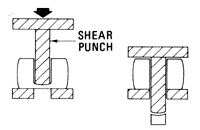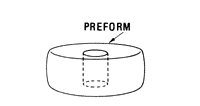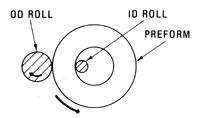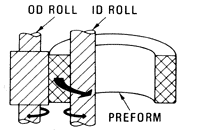| 1. The ring rolling process typically begins with upsetting of the starting stock on flat dies at its plastic deformation temperature - in the case of grade 1020 steel, approximately 2200 degrees Fahrenheit. |
 |
| |
|
| 2. Piercing involves forcing a punch into the hot upset stock causing metal to be displaced radially, as shown by the illustration. |
 |
| |
|
| 3. A subsequent operation, shearing, serves to remove the small punchout ... |
 |
| |
|
| 4. ...producing a completed hole through the stock, which is now ready for the ring rolling operation itself. At this point the stock is called a preform. |
 |
| |
|
| 5. The doughnut-shaped preform is slipped over the ID roll shown here from an "above" view. |
 |
| |
|
| 6. A side view of the ring mill and preform workpiece, which squeezes it against the OD roll which imparts rotary action... |
 |

